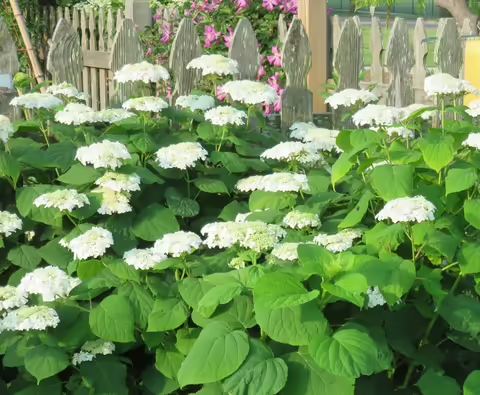Smooth hydrangea (Hydrangea arborescens) is one of only two hydrangea species native to Illinois. This small and often overlooked native shrub is much more prevalent in southern Illinois, although it occasionally occurs in our part of the state as well. Its dainty lacecap flowers attract a wide range of pollinators and its foliage serves as food source for the caterpillars of two native moths, lending ecological value to this attractive, shade-loving native.
Hydrangea flowers
The flower structures on hydrangeas are the subject of much attention, from both an ornamental standpoint and from the perspective of pollinating insects. The compound flowerheads of smooth hydrangea reach full bloom by midsummer, containing hundreds of individual flowers in a flat to dome-shaped structure, called a panicle.
Tiny, fertile flowers occur at the center of the panicle in a massive cluster, with each flowerhead contain 800 or more individual flowers, offering both pollen and nectar to visiting insects. Around the perimeter of most panicles are more showy sterile flowers that offer no support to pollinators, but provide visual interest to humans. This type of flower arrangement is often referred to as a “lacecap” flower since the larger sterile flowers occur along the outer edge of the structure creating a lace-like appearance.
In contrast, many hydrangeas host flower structures referred to as “mophead” flowers. These structures are predominantly the sterile outer flowers of lacecaps, creating a dome shaped panicle that is significantly more showy, yet offers no pollen or nectar.
The rise of smooth hydrangea as a landscape plant
In the early 20th century, smooth hydrangea gained interest from the ornamental horticulture trade with the release of H. arborescens ‘Hills of Snow’. This variety was developed from an individual plant with a natural mutation for mophead flowers. ‘Hills of Snow’, also known as ‘Gradiflora”, was the most popular cultivar for decades, until the introduction of ‘Annabelle’ hydrangea. ‘Annabelle’ came from another naturally occurring mutation for mophead flowers found near Anna, Illinois, as its name implies.
New hydrangea cultivars
Today, plant breeders have moved beyond these naturally occurring mutations to create new cultivars with improved characteristics. While flowers have been some of the focus, these more recent cultivars were also developed with other features in mind, such as more compact habits and sturdier stems.
Smooth hydrangea cultivars with mophead flowers are notorious for flopping over in midsummer due to the weight of large flowers at the branch tips. Individual canes are often sturdier with bigger flowers in their first year of bloom, while subsequent year’s flowerheads are more numerous as the canes branch out, exacerbating the problem.
As a result, many gardeners cut back smooth hydrangea in late winter to focus growth on younger stems with less branch structure to support. The practice does create more resilient shrub canopies that are less likely to flop over.
Many newer cultivars have also sought to preserve pollinator value by focusing efforts on lacecap flower structures with added ornamental appeal, such as more abundant inner flowers (sometime up to 2,000 per head) that create larger flowerheads or slight variations in color to enhance human visual interest. Breeders have worked with individual plants showing promising mutations and have also produced hybridized selections by crossing smooth hydrangea with other North American native hydrangeas, such as ashy hydrangea (H. cinereal) and silver-leaf hydrangea (H. radiata).
Hydrangea trials at Mt Cuba Center
In a recent 5 yr trial, the Mt Cuba Center in Delaware assessed newer Hydrangea arborescens cultivars across a variety of criteria, including pollinator use, ornamental appeal and performance in the landscape. Their assessment included 29 taxa of hydrangea with 13 lacecap and 16 mophead flower types. Lacecap cultivars averaged 143 pollinator visits per plant per year while mophead cultivars were only visited an average of 42 times.
Notable results include the top-rated performer, H. arborescens ‘Hass Halo’ which is a lacecap variety that averaged 192 pollinator visits per year. It was found to have the largest overall flowers in the trail and gained the top rating due to its “flawless performance” in shade settings.
H. arborescens ‘Mary Nell’ was another high-rating cultivar that’s unique lacecap flower has a larger abundance of the more showy sterile flowers, yet still attracted 154 pollinators per year.
Surprisingly, a cultivar (H. arborescens ‘Dardom’) received more pollinator visits per year than the straight species. It was top performer in the landscape and features a smaller size than H. arborescens and larger flowers.
It’s really great to see victories like this in the horticulture industry, where ecological value and ornamental appeal can be combined to create high-value landscape plants. The full report, titled “Wild Hydrangea for the Mid-Atlantic Region” can be accessed at: https://mtcubacenter.org.
